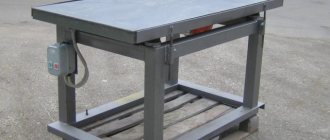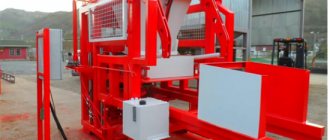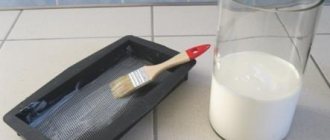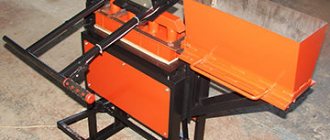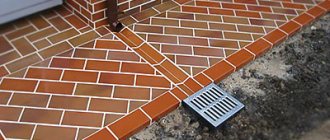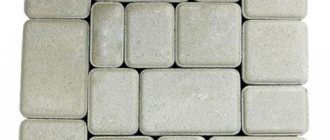The building materials market is literally replete with ready-made dry mixtures, which significantly simplify finishing work. These are multicomponent formulations sold in the form of a dry substance with the addition of plasticizing additives and modifiers.
However, just 20-30 years ago , builders used simple compositions prepared from available components for the construction of buildings, landscaping and finishing. One of these materials is prancing. Let's talk about it in more detail.
Basic concepts of prancing and its varieties
Many people do not know what prancing is. Gartsovka is a dry mixture based on 2 components, which act as the main component and a connecting element. The first component that forms the basis of the mixture is sand, small fractions of expanded clay or calcium. Lime, clay or cement are used for the binding element.
Many people mistakenly confuse grout and cement mortar. Gartsovka is a dry mixture, and the cement mortar is initially based on a proportional volume of water, so the mortar and prawns are two different things.
Depending on the number of components used, simple and complex varieties are distinguished. The first type is based on two components, which is the standard choice for laying paving slabs. The composition of a complex prance can include up to 5 elements, and the use of such a mixture is not limited to one process.
There are degrees of strength that indicate the strength of the mixture. They look like this:
- M-1;
- M-2;
- M-3;
- M-4
Also, the dry mixture can be light or heavy. A light prance consists of elements whose fraction does not exceed 1.25 mm, and a heavy one consists of components whose fraction is more than 2 mm.
Recommendations and common mistakes
When laying paving slabs on top of the grating, experts recommend listening to the following tips. They will help you avoid mistakes:
- It is important to lay out the garnet with a thickness of more than 5 cm. This figure can reach 70 mm.
- It is important to compact all the layers under the paving slabs well so that the resulting paving stones last a long time.
- When laying tiles, you must ensure that each element is 2 cm above the curb.
- The consistency of the paving should be controlled using a long strip or cord. All parts of the paving stones must be at the same height.
Gartsovka is recommended for use in areas with soils that have a low level of moisture absorption.
Dry mix for paving slabs can be used on paths with minimal load.
Advantages and disadvantages
It is not for nothing that the paving slab is used by many specialists in laying paving slabs, because it has a number of advantages.
These include:
- Low cost;
- Possibility of producing large volumes independently;
- Environmental friendliness of the finished mixture;
- Long service life;
- Possibility to restore the coating to its original condition.
These properties make it possible to use garnet as the main material for laying paving slabs, without any competition. However, no building material is without drawbacks. These include:
- The mixture requires the correct proportion. For example, if there is not enough cement in the composition, the end result can quickly crack. Therefore, in order to prepare the mixture yourself, you need to have an excellent “eye” or purchase ready-made options;
- It is inconvenient to make a prance in a container. Therefore, a small area with a flat concrete surface is required;
Taking into account all the disadvantages and advantages, plywood has rightfully been used for many years and deserves to be called a high-quality material for laying paving slabs.
What is it?
In fact, the composition, as such, is not a secret, because back in Soviet times it was successfully used by the most qualified builders. Light and easy-to-prepare gartzovka (the composition of which is cement, sand, lime) will serve as a good fastening material. Where can it be used ?
Application and composition
In fact, the range of applications for this mixture is quite wide: construction work (external and internal), plastering of stone, wooden and even concrete surfaces. Prancing for screeding is very popular ; with its help you can lay bricks, putty and level walls (and it will also fit perfectly on ceilings). Read more about what kind of putty you can use to level a ceiling here. It is also interesting that paving slabs , both as a layer between the material and the concrete base, and for grouting joints.
vote
Article rating
Application area
Due to its excellent characteristics and low cost, garnet is popular in many areas of finishing and construction. Basically, dry mixture is used in the following processes:
- Laying paving slabs;
- Creation of floating floors;
- Plastering walls;
- Finishing of other surfaces.
Paving slabs are laid in large volumes. Accordingly, a large amount of binding material is wasted, which costs a lot of money. Gartsovka allows you not only to save money, but also to become a reliable support for paving stones of any type.
Plastering walls and ceilings is often done using a plastering machine. Moreover, its production is carried out in domestic conditions by the hands of builders. The dry mixture is excellent for leveling walls and ceilings, and large unevenness will be corrected with minimal investment and effort.
Advantages and disadvantages
The praises of semi-dry screed can be sung forever, but, like any material for construction, this dry mixture has its own advantages and disadvantages. Details in the table.
Possibility of self-cooking.
If desired, the mixture can be made in a variety of quantities.
Unconditional safety in an environmentally friendly and natural project: there are no chemically active substances in the composition.
Forms a strong coating that can always be reconstructed to the original level.
To cook in large quantities, you will need a large, smooth surface area.
Sensitivity to proportions. If the amount of cement is below the recommended standards, the coating will crack.
If you have no experience in preparing such mixtures, it is better not to take risks, but to purchase semi-dry ready-made screed.
Types of prancing mixture
As mentioned earlier, prancing has several types. The use of each type depends on many factors, so the existence of several varieties is natural.
Depending on the number of elements in the finished mixture, there are two types of prancing - simple and complex. The first option consists of two main components: a base (sand or calcium) and a binder (gypsum or cement). A complex mixture includes the use of more than 3 components in the base (the number sometimes reaches 5 elements). For example, to level walls where a large layer is needed, a complex grout is used, which includes sand, cement and shell rock.
There are also 2 other types of dry mixture, which differ in the fraction of components. The lightweight prance has materials whose fraction does not exceed 1.25 mm. The components of the heavy mixture have a fraction of 2 mm or more (often used for leveling walls).
How to make the mixture yourself
In an innovative project, the production process of semi-dry screed does not seem difficult. To do this you will need a shovel type, a striker and a sieve for sifting sand. As a striker, you can use an ideal surface made of concrete or a metal sheet, the dimensions of which allow you to prepare a sufficient amount of the mixture.
For a good composition, it is important to exclude any lumps and stones from the elements; therefore, the filler should be carefully sifted.
The preparatory process for semi-dry screed looks like this.
- Sand is poured onto the striker in the amount necessary to produce the required volume of the mixture.
- The filler is poured into a bed or not a very large pile, which needs to be lightly leveled.
- Add a binder (cement and lime) and begin to prance: mix the elements until you get a uniform mass.
- In a pile of mixed components, make a small well, where water is added in portions. The composition is stirred again until the liquid is completely absorbed by the elements.
- The procedure is repeated until the solution reaches the required consistency.
It is necessary to pay attention that the amount of semi-dry screed should be such that you have time to use the composition before it dries, otherwise it will not be easy to clean the striker in the future.
materials directly depend on the required strength of the composition. The recipes for individual formulations are given in the table.
Note that you can purchase semi-dry screed ready-made: the mixture is included in the selection of any building materials store.
Brand of construction mixture
If we talk about the factory production of prawns, there is the concept of a brand of construction mixture. This concept is denoted by the letter “M” and means the proportion of the binding component to the base. There are 4 brands in total that indicate the composition of the seal for laying paving slabs.
For example, M-2 says that for 1 part of cement in a dry mixture there are 2 parts of sand or other material. M-1 is the most fragile grade and is rarely used, while M-4 is most often purchased for use in various applications.
If we talk about the scope of application, then M-3 is quite sufficient for laying paving slabs. It is better to plaster walls and other surfaces with the “M-4” grade, which will ensure maximum adhesion of the elements to the plane.
Factory production is not cheaper, but it is more reliable, because the proportions in the finished dry mixture are strictly maintained. This ensures maximum viscosity during laying of paving slabs and subsequent service life.
Step-by-step preparation of the solution
Now we will look at several options for properly preparing a solution for the production of paving slabs. Let's start with the simplest methods and gradually move on to more complex ones. Recent Entries
Chainsaw or electric saw - what to choose for the garden? 4 mistakes when growing tomatoes in pots that almost all housewives make Secrets of growing seedlings from the Japanese, who are very sensitive to the soil
When you are preparing a solution for the production of paving slabs at home, it is not necessary to follow the standards that are recommended for enterprises. If you try really hard, you can use any recipe for a concrete mixture to produce this material. Below are some of the most common ones.
Preparation of dry cement-sand mortar in a ratio of 1:1.5. Gradually add water to the sand and cement and bring the mixture to the consistency of thick sour cream. For better mixing, you must use a hammer drill or drill equipped with a “mixer” attachment. When the desired consistency is obtained, pour it into prepared forms.
Another way to prepare a mixture for paving slabs. You need to take two buckets of sand and fill it with six liters of water, and then mix everything thoroughly. After this, you need to add two buckets of cement to the mixture.
When the mixture is ready, you need to fill in five more buckets of sand, carefully fill everything with water, which will require about six liters. The result should be a solution with a thick consistency that should not stick to the trowel. The finished mixture must be mixed for several minutes and then loaded into the mold.
If a plasticizer is added to the finished solution as an additive, the properties of the composition are significantly expanded. The composition acquires elasticity and becomes more resistant to low temperatures.
When adding plasticizers, care must be taken to ensure that the composition remains thick. When the mixture is ready, it is distributed into molds, and then tiles are formed by vibration.
To increase the strength of the solution, crushed stone, screenings or microsilica must be added to the composition. In this case, there is no need for a hammer drill. If you use a mixer for stirring, then breakage cannot be avoided. It is best to use a shovel. To make the task of preparing the mixture easier, you can use a concrete mixer.
If paving slabs are planned to be produced on a production scale, then it is necessary to take a more responsible approach to the preparation of concrete. You need to familiarize yourself with the state standards in advance and adhere to these parameters when preparing the mixture. It is necessary to approach the selection of material with special care.
It is also important to consider the grade of cement, which must be at least M500 and not contain additives. Crushed stone for preparing the mixture must be granite, fraction 5–10 mm. Additives must be used sparingly
Additives must be used sparingly.
For coloring, it is best to use imported colors made in Germany or the Czech Republic. If the choice fell in favor of a domestically produced dye, then the filling should be increased by 80%. The dosage of cement and dyes cannot be changed, otherwise it will affect the quality characteristics of the paving slabs and their color will be inconsistent.
Features of preparing plasticizer
It should be remembered that the preparation of the plasticizer must be taken care of in advance. This is done as follows. Plasticizer S-3 is poured into water heated to 40 degrees. Here it is necessary to adhere to the proportion 1:2. Then it is mixed for 15 minutes with a hammer drill with a “mixer” attachment. When mixing is complete, the solution must be left for some time.
It is best to prepare the solution in the evening. In the morning, when the preparation of the concrete mixture begins, it will be enough to stir the mixture for 15 minutes, after which it can be used.
All materials that will be used to prepare the concrete mixture must be located within walking distance. It is advisable to decide in advance how many measuring containers will be used for each component of the mixture.
The workplace should be equipped as follows: cement, sand and crushed stone are poured onto sheets of metal, which are laid around the concrete mixer at swing distance. Nearby there is a container that needs to be filled with water in advance.
Making prancing with your own hands
Experienced specialists know how to make a prance. Before kneading the prawn with your own hands, you need to purchase all the components and prepare the necessary tools (sieve, shovel).
The process of preparing the dry mixture is as follows:
- Filler (sand, calcium or other substances) is poured through a sieve onto a flat concrete surface;
- The base layer is leveled with a shovel;
- Similarly, a binder (clay or cement) is poured through a sieve;
- The entire layer is thoroughly mixed with a shovel to achieve uniform distribution of the components among themselves (it is very important to avoid large elements and lumps).
The concrete surface on which the dry mixture will be prepared must be clean of foreign elements and protected. The larger the surface area, the more prancing can be made with less effort.
Many people may think that they forgot to add water during the process. However, this action will lead to the preparation of cement mortar and the whole main idea will be lost.
If you are talking about preparing a paving slab with your own hands for laying paving slabs, you must maintain a proportion that will correspond to the “M-4” brand. That is, to 1 part of cement you need to add 4 parts of sand or other filler.
Important! When preparing a dry mixture with your own hands, you must remember the correct ratio and reasonable amount of cement or other binding material. Otherwise, the finished layer will have poor characteristics.
How to calculate the required amount of prancing
When calculating the proportions of the paving slabs, it is important to focus on the geometric dimensions of the area that will be involved in laying out the mixture.
The consumption of the prancing components is calculated as follows:
- sand consumption: multiply the area of the path by the thickness of the layer (3 - 8 cm);
- cement consumption: take 3 – 5 times less than the calculated sand.
In this case, the compaction coefficient will be 1.18 if a vibrating plate is used.
The consumption of crushed stone is calculated in the same way, but its compaction coefficient will be equal to 1.3.
Attention! Professionals advise focusing on average values, for example, 4 - 5 kg/m2 with 3 mm seams. Since the consumption of materials for dry mixture and filling joints depends on various factors.
Calculator for calculating paving slabs
To correctly calculate the amount of materials for laying out paving slabs with your own hands, it is recommended to use a special calculator. It is enough to select the name of the building mixture, indicate the area and the required layer thickness. When you click on the “Calculate” button, the result will appear.
https://protrotuarnujuplitku.ru/kalkulyatory/raschet-kolichestva-suhoj-smesi.html
Technology for laying paving slabs on a paving slab
Laying paving slabs on a paving slab differs from the standard method. Each tile is placed on a dry mixture. However, the success of the process and the quality of the masonry are not inferior to any traditional method. Also, dry mixture is often used not only on flat surfaces, but also on inclined planes.
The entire process of laying paving slabs on a paving slab can be divided into 3 stages, which should be taken very seriously.
Preparatory
If the prance has not yet been prepared, you must complete all the steps for making it yourself, which are described above. You can also use a ready-made mixture from any manufacturer.
The paving slab compound is poured onto the surface that will be covered with paving stones or paving slabs. The plane must be prepared for this: the humps are knocked down, and the holes are filled with rubble or sand. After finishing the planning, a layer of crushed stone is poured, the thickness of which is from 10 to 15 cm, depending on the finished project and the surface level. It is recommended to plan the surface using a thread that is pre-leveled.
Fencing
The fencing is carried out strictly according to the project, which is agreed with the customers. For this purpose, ready-made borders are used or sides are poured using cement mortar.
Fencing with curbs is safer and faster, because they can always be adjusted in height using a mallet. Cement sides must be poured onto the formwork, which is pre-set in height and size.
A storm drain (drain for rainwater) is installed on the inside of the curbs, if this is provided for by the project.
Laying
The dry mixture is poured onto the prepared and fenced surface. The layer of garter should range from 5 to 7 cm, which provides high-quality support for the future sidewalk. Material consumption depends on the thickness of the pillow and its purpose. The prancing layer is leveled and adjusted to the level using a rule. It is best to tension the thread according to the marks marked with a level.
A very optional, but important step during the preparation of the prance is tamping the pillow using improvised materials or casting it out. This process will provide better grip, but greater dry mixture consumption.
Paving stones or paving slabs are laid on the finished dry mixture cushion. As always, each tile is adjusted to the level using a rubber mallet to avoid damaging the product. All elements of the paving slab puzzle must be correctly joined. This will be facilitated by a long time for correct alignment of the tiles, because the grout does not harden like cement mortar.
The seams are sealed using a fine-grained compound that resembles powder.
Using a dry mixture.
Once the paving slabs are laid, the entire surface is hosed down in small quantities to ensure the pavement adheres to the base. Many are waiting for the first rain.
It is not recommended to use the method of laying paving slabs using a dry mixture where the soil moisture exceeds the normal level. Also, the prance is used in pedestrian areas where the load on the sidewalk will be minimal. Roadways regulate the use of cement mortar for paving.

